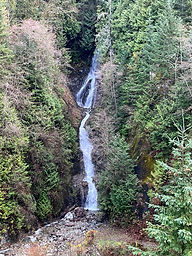Fall Garden Tips: October Edition
- kc dyer

- Oct 7, 2023
- 3 min read
Pruning and Bulbs and Mulching, Oh My!
The Mary Comber Miles Indigenous Garden volunteer group believes in life-long learning. As one member said, “The joy of this lovely small group is that no one is an expert gardener, but we all share what we know with each other.” Lions Bay residents interested in joining in this initiative are welcome.
Should You Prune Hydrangeas in the Fall? It depends.

There is a lot of advice online and elsewhere about this issue so it is worth doing your own research. Hydrangea pruning rules are important because you can lose a wonderful colour show by pruning at the wrong time. It all depends on the type of hydrangea: Panicle, Smooth, Oakleaf or Mophead.
Master gardener Brian Minter warns against pruning any hydrangea in late summer or early spring. (The new buds set August through September.) Amy Draiss (“Gardening Knowhow”) points out that some types (Oakleaf Hydrangea Quercifolia and Mophead Hydrangea Macrophylla) bloom on 'old wood,' meaning their flower buds formed in the prior season. By cutting back an 'old wood' stem that contains the flower buds for the next season, you will lose next year’s flowers. All Mophead hydrangeas grow on old wood but some newer varieties bloom on both old and new stems so Amy Draiss recommends only pruning mopheads just after the flowers have faded.
The flower buds of Panicle (Pee Gee Hydrangeas or Hydrangea Paniculate), and smooth hydrangea species (Annabelle Hydrangeas or Hydrangea arborescens), grow on “new wood” only. To complicate things, some newer varieties combine both traits and bloom on both old wood and new wood. It is easy to see why these varieties might have a better survival rate in harsher climates since the absent flower buds aren’t exposed to the cold winter conditions. Although these varieties can be pruned in the fall, it is recommended to prune both panicle and smooth hydrangeas in spring to reduce any possibility of injury.
October is Garlic Planting Time
Although garlic can be planted almost any time in the fall, Linda Gilkeson of West Coast Gardening recommends waiting until the soil is cold and wet. According to Linda, if you plant while the soil is warm and dry, this increases the risk of infection with Blue Mold Rot, a short-lived soil fungus that thrives in dry soil at soil temperatures of 22-25 degrees. She recommends planting once the soil is cold and wet and then only choosing healthy cloves.
Seeds of Diversity's Great Canadian Garlic Collection is a national project that explores and documents the many varieties of garlic grown in Canada. Their goal is to grow as many varieties as possible in all of Canada's major agricultural areas and to record their success and characteristics. Bulbils (the tiny bulbs that replace the garlic flower blossom) can be ordered from this organization for varieties that are likely to grow successfully on the West Coast. It's important to note that bulbils will take longer than cloves to produce a harvest.
What to Do with All of Those October Leaves? Mulch!

September and October are the months to collect fallen leaves for winter mulching and to stockpile for next summer’s mulch. Linda Gilkeson recommends saving the first dry leaves of fall under cover or in waterproof bags for next summer’s mulching. Leaves don’t decompose if they are kept dry over winter. Leaves that have been rained on should be spread onto the garden around the base of plants and over beds that aren’t still producing crops. She recommends layers of dry leaves 15 centimetres/six inches deep everywhere. Over the winter the sodden leaves will pack down. Wait until late November or early December to mulch cover carrots, beets and other root crops that are no longer growing and therefore don’t need sunlight. This will protect roots from freezing by creating a 'living root cellar'.
Have thoughts to share about autumn gardening? Leave your comments below or email us at editor@lionsbaywatershed.ca








Comments